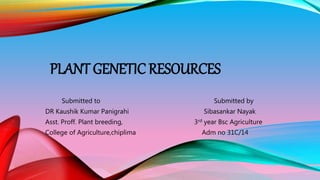
Presentation on Plant Genetic Resources
- 1. PLANT GENETIC RESOURCES Submitted to Submitted by DR Kaushik Kumar Panigrahi Sibasankar Nayak Asst. Proff. Plant breeding, 3rd year Bsc Agriculture College of Agriculture,chiplima Adm no 31C/14
- 2. CONTENTS •Plant genetic resources– • types of seed collections • germplasm activities • exploration etc. • merits and demerits of exploration • collection of germplasm
- 3. TYPES OF SEED COLLECTIONS • Types of Seed Collections • Based on the use and duration of conservation, seed collections are of three types: 1) Base collections 2) Active collections 3) Working collections
- 4. 1. Base Collections: Base collections include maximum number of accessions available in a crop. These are meant for long term conservation (upto 50 years or more) and are stored at 18- or 20 0C in hermetically sealed containers. The seeds are dried to 5+-1 percent moisture and have more than 85% initial seed viability. These collections are distributed only for the purpose of regeneration. These are used only when germplasm from other sources is not available for use in breeding. It is also known as principle collection refers to the whole collection.
- 5. 2. Active Collections: This category of germplasm is actively utilized in breeding programme are conserved for medium term (8-10 years or more). These collections stored at zero degree celcius with moisture content around 8%. Germination test is carried out after every 5-10 years to assess the reduction in seed viability.
- 6. 3. Working Collections: There collections are frequently utilized by breeders in their crop programmes . These are stored for short term ( 3 to 5 years ). The seed is stored at 5-10 with moisture content of 8-10%. This is another category of seed collections called core collection. It refers to subset of base collection which represents the large collection or base collection. In other words, core collection is a limited set of accessions derived from existing germplasm collections, chosen to represent the genetic in the whole collection.
- 9. Germplasm Activities There are six important activities related to plant genetic resources: 1) Exploration and collection, 2) Conservation 3) Evaluation 4) Documentation 5) Distribution, and 6) Utilization.
- 10. Exploration and Collection Exploration refers to collection trips and collections refer to to tapping of genetic diversity from various sources and assembling the same at one place. This process takes into accounts six important items, viz. 1) Sources of collection 2) Priority of collection 3) Agencies of collection 4) Methods of collection 5) Methods of sampling 6) Sample size
- 11. 1. Sources of Collection: There are five important sources of germplasm collections: viz 1) Centre of diversity, 2) Gene banks, 3) Gene sanctuaries, 4) Seed companies, and 5) Farmers field’s. Moreover, collections can be local exploration trips to the of crop diversity.
- 12. GENE BANK FARMER FIELD
- 13. 2. Priority of Collection: The next important step in the germplasm collection is to fix priority of collection. Some areas of diversity have been threatened more than others by the danger of extinction. Similarly, some crop species have more risk, of extinction than others. Hence, endangered areas and endangered species should be given priority for germplasm collection.
- 14. 3. Agencies of Collection: The risk of germplasm collection is undertaken by crop research institutes and state agricultural universities in collaboration with National bureau of plant Genetic Resources. New Delhi for indigenous collections. For global collection the task is undertaken in collaboration with International Plant Genetic Resources, Institute (IPGRI), Italy.
- 16. 4. Method of Collection: Germplasm collections are made in four principal ways: viz. 1) Through expeditions to the areas or regions of genetic diversity, 2) By personal visit to gene bank centre, 3) Through correspondence ,and 4) Through exchange of material.
- 18. 5. Method of Sampling: There are two sampling methods for collection of germplasm from the regions of diversity, viz. 1) Random sampling, and 2) Biased sampling, random sampling is effective in capturing of alleles for biotic stresses, whereas non random or biased sampling is useful in collection of morphologically distinct genotypes. Hence, it is advised that both as well as biased sampling procedures should be adopted to tap the maximum genetic diversity of a crop species.
- 19. 6. Sample Size: The sample size should be such that 95% of the total genetic diversity can be captured from the area of collection. To achieve this goal, 50 to 100 individuals should be collected per site with seeds per plant. As wide as possible range of habitats should be sampled for capturing maximum genetic diversity.
- 20. Merits and Demerits Exploration and Collection of Germplasm Merits: 1. Collection helps in tapping crop genetic diversity and assembling the same at one place. It reduces the loss of genetic due to genetic erosion. 2. Sometimes, we get material of special interest during exploration trips.
- 21. 3. Sometimes, we come across a new plant species during the process of collection. 4. Collection also helps in saving certain genotype from extinction. Once the material is collected, it can be maintained further in the germplasm.
- 22. Demerits: 1. Collection of germplasm especially from other countries, sometimes leads to entry of new diseases, new insects and new weeds. 2. In the remote areas, the collector sometimes has encounter with animals like elephants, rhinos, tigers, lions and snakes which involve of life.
- 23. 3. Collection is a tedious job. The collection has to be made generally from uncultivated areas like hills, mountains, river valleys and forests, where the collector faces problems of boarding, lodging and transportation 4. Transportation of huge collections also poses difficulties in the exploration and collection
